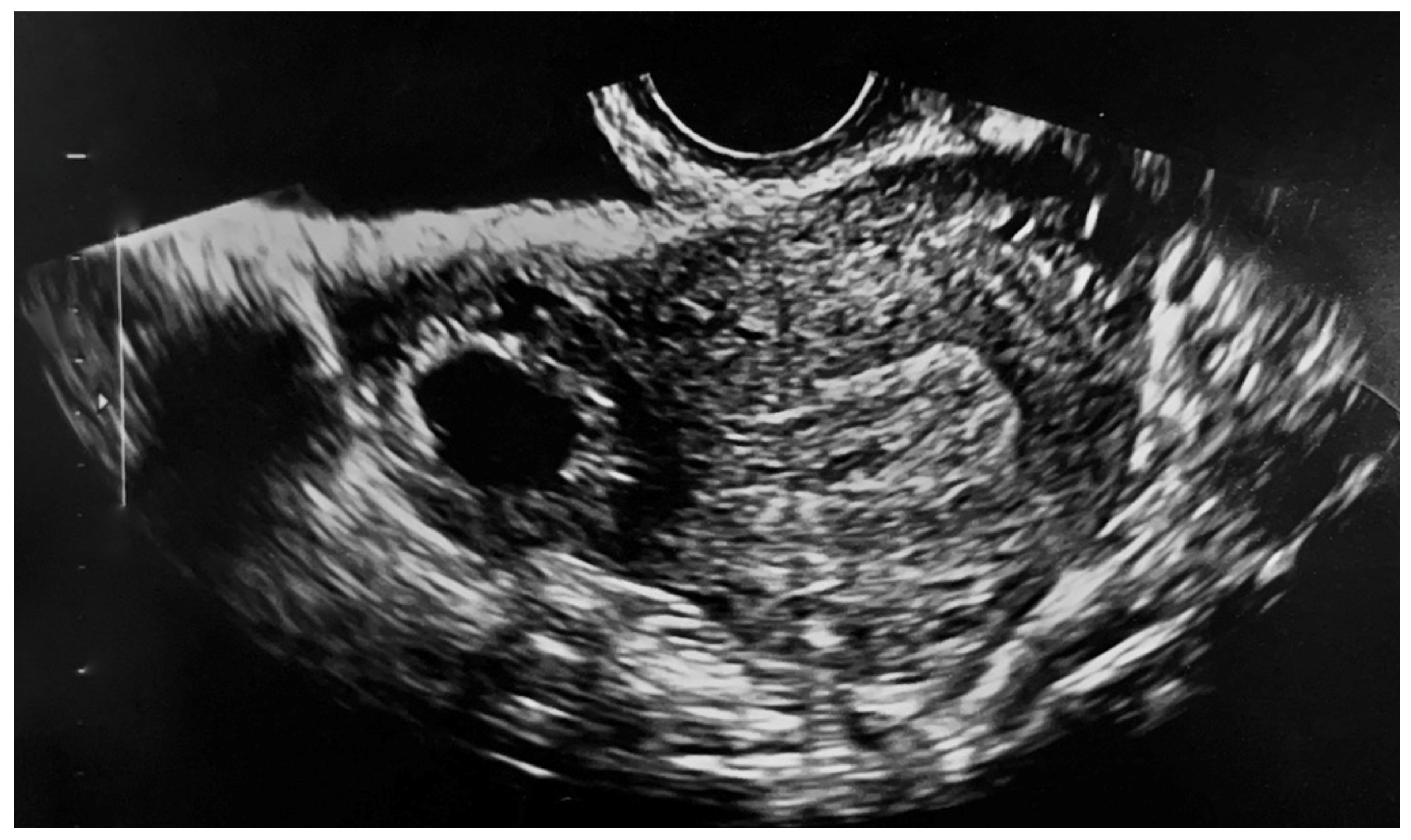Surgical Treatment Following Failed Medical Treatment of an Interstitial Pregnancy
Abstract
:1. Introduction
2. Case Presentation
3. Discussion
4. Conclusions
Author Contributions
Funding
Institutional Review Board Statement
Informed Consent Statement
Data Availability Statement
Conflicts of Interest
References
- Brincat, M.; Bryant-Smith, A.; Holland, T.K. The diagnosis and management of interstitial ectopic pregnancies: A review. Gynecol. Surg. 2019, 16, 2. [Google Scholar] [CrossRef] [Green Version]
- The ESHRE Working Group on Ectopic Pregnancy; Kirk, E.; Ankum, P.; Jakab, A.; Le Clef, N.; Ludwin, A.; Small, R.; Tellum, T.; Töyli, M.; Van den Bosch, T.; et al. Terminology for describing normally sited and ectopic pregnancies on ultrasound: ESHRE recommendations for good practice. Hum. Reprod. Open 2020, 2020, hoaa055. [Google Scholar] [CrossRef] [PubMed]
- RCOG. Diagnosis and Management of Ectopic Pregnancy. BJOG Int. J. Obstet. Gynaecol. 2016, 123, e15–e55. [Google Scholar] [CrossRef] [PubMed] [Green Version]
- Moawad, N.; Mahajan, S.T.; Moniz, M.H.; Taylor, S.E.; Hurd, W.W. Current diagnosis and treatment of interstitial pregnancy. Am. J. Obstet. Gynecol. 2010, 202, 15–29. [Google Scholar] [CrossRef] [PubMed]
- Oktay, K.; Harvey, B.; Partridge, A.H.; Quinn, G.; Reinecke, J.; Taylor, H.S.; Wallace, W.H.; Wang, E.T.; Loren, A.W. Fertility Preservation in Patients with Cancer: ASCO Clinical Practice Guideline Update. J. Clin. Oncol. 2018, 36, 1994–2001. [Google Scholar] [CrossRef] [PubMed]
- Stabile, G.; Romano, F.; Buonomo, F.; Zinicola, G.; Ricci, G. Conservative Treatment of Interstitial Ectopic Pregnancy with the Combination of Mifepristone and Methotrexate: Our Experience and Review of the Literature. BioMed Res. Int. 2020, 2020, 8703496. [Google Scholar] [CrossRef] [PubMed]
- Hiersch, L.; Krissi, H.; Ashwal, E.; From, A.; Wiznitzer, A.; Peled, Y. Effectiveness of medical treatment with methotrexate for interstitial pregnancy. Aust. N. Z. J. Obstet. Gynaecol. 2014, 54, 576–580. [Google Scholar] [CrossRef] [PubMed]
- McGrattan, M.; Chan, W.; Murji, A. A Purse-String Approach to Laparoscopic Cornuotomy for Interstitial Ectopic Pregnancy. J. Obstet. Gynaecol. Can. 2022, 44, 75–76.e2. [Google Scholar] [CrossRef] [PubMed]
- SIGO. Linee Guida per Ecografia Ostetrica e Ginecologica; SIGO: Roma, Italy, 2021. [Google Scholar]
- Jurkovic, D.; Mavrelos, D. Catch me if you scan: Ultrasound diagnosis of ectopic pregnancy. Ultrasound Obstet. Gynecol. 2007, 30, 1–7. [Google Scholar] [CrossRef] [PubMed]
- Stabile, G.; Romano, F.; Zinicola, G.; Topouzova, G.A.; Di Lorenzo, G.; Mangino, F.P.; Ricci, G. Interstitial Ectopic Pregnancy: The Role of Mifepristone in the Medical Treatment. Int. J. Environ. Res. Public Health 2021, 18, 9781. [Google Scholar] [CrossRef] [PubMed]
- Delplanque, S.; Le Lous, M.; Flévin, M.; Bauville, E.; Moquet, P.Y.; Dion, L.; Fauconnier, A.; Guérin, S.; Leveque, J.; Lavoué, V.; et al. Effectiveness of conservative medical treatment for non-tubal ectopic pregnancies: A multicenter study. J. Gynecol. Obstet. Hum. Reprod. 2020, 49, 101762. [Google Scholar] [CrossRef] [PubMed]
- ACOG. ACOG Practice Bulletin No. 191: Tubal Ectopic Pregnancy. Obstet. Gynecol. 2018, 131, e65–e77. [Google Scholar] [CrossRef] [PubMed]
- Stovall, T.G.; Ling, F.W. Single-dose methotrexate: An expanded clinical trial. Am. J. Obstet. Gynecol. 1993, 168, 1759–1765. [Google Scholar] [CrossRef]
- Halperin, R.; Vaknin, Z.; Schneider, D.; Yaron, M.; Herman, A. Conservative Management of Ectopic Pregnancy with Fetal Cardiac Activity by Combined Local (Sonographically Guided) and Systemic Injection of Methotrexate. Gynecol. Obstet. Investig. 2003, 56, 148–151. [Google Scholar] [CrossRef] [PubMed]
- García, M.T.G.; Benitez, G.A.; Belda, B.B.; Rodríguez, C.C.; Merlo, G.G. Medical therapy (methotrexate and mifepristone) alone or in combination with another type of therapy for the management of cervical or interstitial ectopic pregnancy. Eur. J. Obstet. Gynecol. Reprod. Biol. 2012, 165, 77–81. [Google Scholar] [CrossRef] [PubMed]
- Perdu, M.; Camus, E.; Rozenberg, P.; Goffinet, F.; Chastang, C.; Philippe, H.-J.; Nisand, I. Treating ectopic pregnancy with the combination of mifepristone and methotrexate: A phase II nonrandomized study. Am. J. Obstet. Gynecol. 1998, 179, 640–643. [Google Scholar] [CrossRef]
- Barnhart, K.T.; Gosman, G.; Ashby, R.; Sammel, M. The medical management of ectopic pregnancy: A meta-analysis comparing “single dose” and “multidose” regimens. Obstet. Gynecol. 2003, 101, 778–784. [Google Scholar] [CrossRef] [PubMed]
- Conti, V.; Luciano, G.; Pecoraro, G.; Iovieno, R.; Filippelli, A.; Guida, M. Multidosing Intramuscular Administration of Methotrexate in Interstitial Pregnancy with Very High Levels of β-hCG: A Case Report and Review of the Literature. Front. Endocrinol. 2018, 9, 363. [Google Scholar] [CrossRef]



Publisher’s Note: MDPI stays neutral with regard to jurisdictional claims in published maps and institutional affiliations. |
© 2022 by the authors. Licensee MDPI, Basel, Switzerland. This article is an open access article distributed under the terms and conditions of the Creative Commons Attribution (CC BY) license (https://creativecommons.org/licenses/by/4.0/).
Share and Cite
Restaino, S.; De Gennaro, E.; Floris, S.; Stabile, G.; Zinicola, G.; Sorrentino, F.; Vizzielli, G.; Driul, L. Surgical Treatment Following Failed Medical Treatment of an Interstitial Pregnancy. Medicina 2022, 58, 937. https://doi.org/10.3390/medicina58070937
Restaino S, De Gennaro E, Floris S, Stabile G, Zinicola G, Sorrentino F, Vizzielli G, Driul L. Surgical Treatment Following Failed Medical Treatment of an Interstitial Pregnancy. Medicina. 2022; 58(7):937. https://doi.org/10.3390/medicina58070937
Chicago/Turabian StyleRestaino, Stefano, Elena De Gennaro, Stefano Floris, Guglielmo Stabile, Giulia Zinicola, Felice Sorrentino, Giuseppe Vizzielli, and Lorenza Driul. 2022. "Surgical Treatment Following Failed Medical Treatment of an Interstitial Pregnancy" Medicina 58, no. 7: 937. https://doi.org/10.3390/medicina58070937





